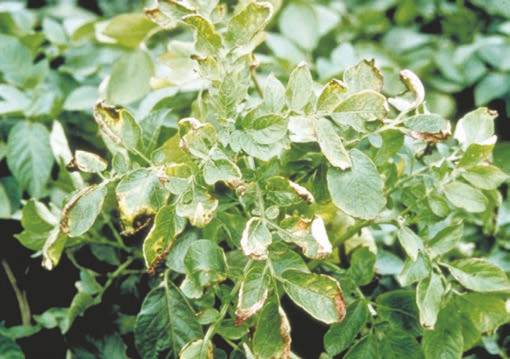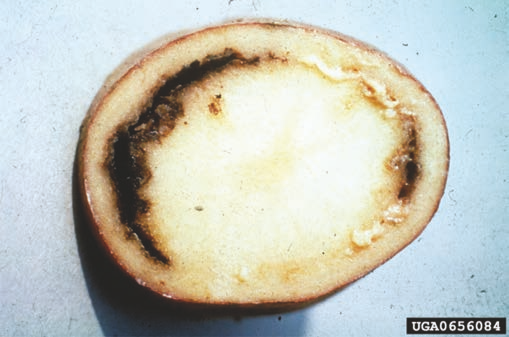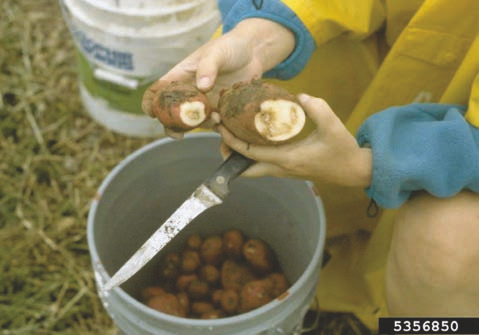Bacterial Ring Rot in Alaska Potato Crops
PMC-00340 View this publication in PDF form to print or download.
by Stephen C. Brown
Background
Bacterial ring rot (BRR) is a very serious disease of potatoes. The disease was discovered in Germany during the late 1800s and spread to the United States in the 1930s. It also occurs in Alaska and has been found in the Mat-Su Valley, Fairbanks and Delta Junction.
The disease is caused by the bacterium Clavibacter michiganensis subsp. sepedonicus. Ring rot bacteria do not persist for very long in soil, but they can last for years in volunteer tubers and field debris. The bacterium can be transported from field to field and farm to farm on shoes, clothes, tires, tractors, implements, seed knives, storage containers, sacks, sorting equipment or any surface that comes in contact with it. The bacterium exudes a protective slime layer that allows it to live on storage and farm equipment surfaces for more than five years. Ring rot is managed through proper sanitation, the use of clean certified seed and constant vigilance. There is no known pesticide for the control of BRR or most other vegetative bacterial diseases.
Symptoms
Initial symptoms of ring rot are usually detected as wilting on lower plant leaves. The leaves will be slightly rolled at the margins and will appear a lighter green than healthy leaves. The leaf tissue between the veins will turn yellow. Eventually, margins of the leaves will turn brown and brittle and the stems will yellow and die. If the stem just above the seed piece of an infected plant is cut and squeezed, a creamy or cheesy-white secretion may appear.
Detecting ring rot in the above ground portion of plants can be difficult. Only a few stems may show yellowing, and sometimes there are no above-ground symptoms at all. Symptoms in the tubers usually do not occur until the plant has wilted. When an infected potato is cut crosswise from the stem (stolon end), the breakdown of the vascular ring will likely be observed. The skin will form sunken areas and cracks. A cheesy/creamy or brownish ooze may be present in severe infections. Symptoms of ring rot can vary widely and plants with the disease often do not exhibit the extreme symptoms described above. A laboratory test for bacterial ring rot is the only way to confirm the disease.
Disease Control & Management

As previously mentioned, there is no identified pesticide to control ring rot. An absolute commitment to using only certified disease-free seed potatoes and rigorous sanitation practices are the best defenses against bacterial ring rot. Although there is zero tolerance for the presence of ring rot when seed potatoes are being certified, it is not a 100% guarantee that the disease is not present. Good sanitation using disinfectants must be practiced at all times.
Although ring rot does not survive in the soil long, do not plant potatoes for at least one year in fields where the disease has been found. Make every effort to remove any volunteer potatoes from those fields as well.
Any equipment that may come into contact with seed potatoes should be washed with 120°F or hotter soapy water under pressure. This includes seed cutters, fork lifts, containers and planters. However, hot soapy water will not completely eliminate ring rot. A disinfectant must be used if bacteria have been detected on the farm or in storage areas. These two steps — washing and disinfecting — work together. Almost all disinfectants are inactivated by dirt and organic matter; pressure washing cleans the equipment and lets the disinfectant do its job.


Appropriate Disinfectants
There is no “perfect” disinfectant for use on bacterial ring rot. Effectiveness, cost, availability and toxicity to nontarget organisms such as people and fish are all important considerations. Below is a list of disinfectants suitable for use in Alaska. For more in-depth information, see the Iowa State University publication Disinfection 101.
- Bleach — A 10% bleach solution (1 part household bleach to 9 parts water) is effective, inexpensive and readily available. Many disinfectants have reduced efficacy when used with hard water. This is not the case with bleach.
- Alcohols — Ethyl and isopropyl alcohol are effective when used at the appropriate concentration. A concentration of 70-90% alcohol is actually more effective at killing bacterial ring rot than higher concentrations, e.g., 95%.
- Iodine — Betadyne brand and Providone brand iodine compounds are effective and considered relatively safe.
- Hydrogen Peroxide — 5-20% concentrations of hydrogen peroxide are effective against bacterial ring rot. However, home-use formulations of hydrogen peroxide are often less than 5% concentration. Be sure to check the bottle label.
- QACs — Quaternary ammonium compounds (QAC) such as Roccal and Zepharin are disinfecting detergents that are effective against bacterial ring rot. Unlike bleach and alcohols, they also have some residual action. It is important to note they lose their effectiveness in hard water and are toxic to fish.
References
Ohio Vegetable Production Guide. 2010. Ohio State University Extension Bulletin 672.
Stevenson, Walter R. , Rosemary Loria, Gary D. Franc and D. P. Weingartner, eds. 2001. Compendium of Potato Diseases. St. Paul, Minn: American Phytopathological Society Press.
CropWatch: Potato Education Guide. 2011. University of Nebraska-Lincoln, http://cropwatch.unl.edu/potato-education-guide.
Dvorak, Glenda. 2008. Disinfection 101. The Center for Food Security & Public Health, Iowa State University, www.cfsph.iastate.edu/ BRM/resources/Disinfectants/Disinfection101.pdf.
To simplify information, trade names of products have been used. No endorsement of named products by the University of Alaska Fairbanks Cooperative Extension Service is intended, nor is criticism implied of similar products that are not mentioned.
Stephen C. Brown, Extension Faculty, Agriculture and Horticulture. Originally written by Stephen Brown and William L. Campbell, Alaska Division of Agriculture Plant Materials Center, and Jeffrey Smeenk, former Extension Horticulture Specialist.
Reviewed August 2020

